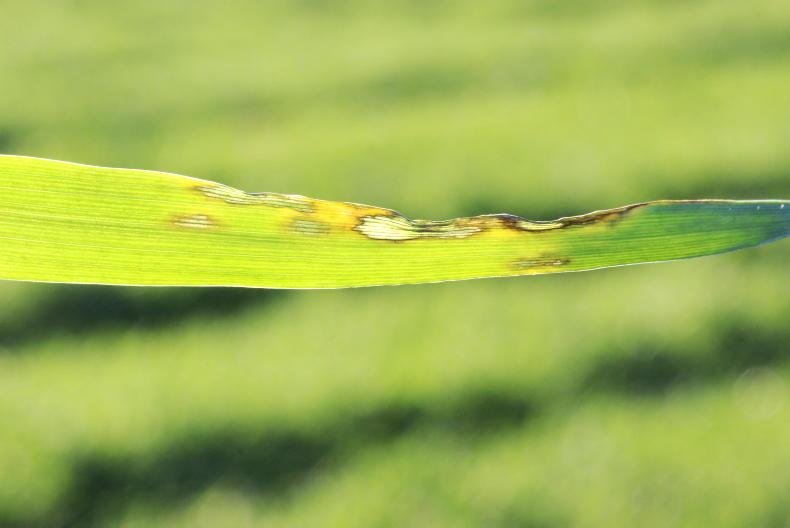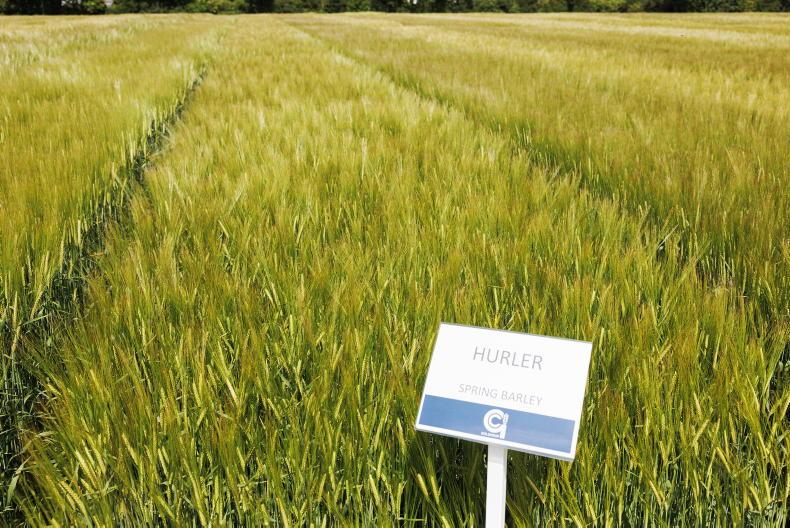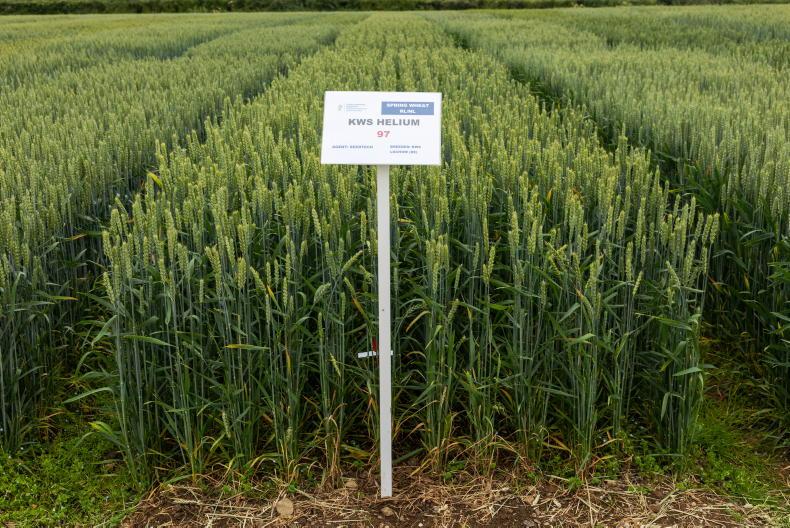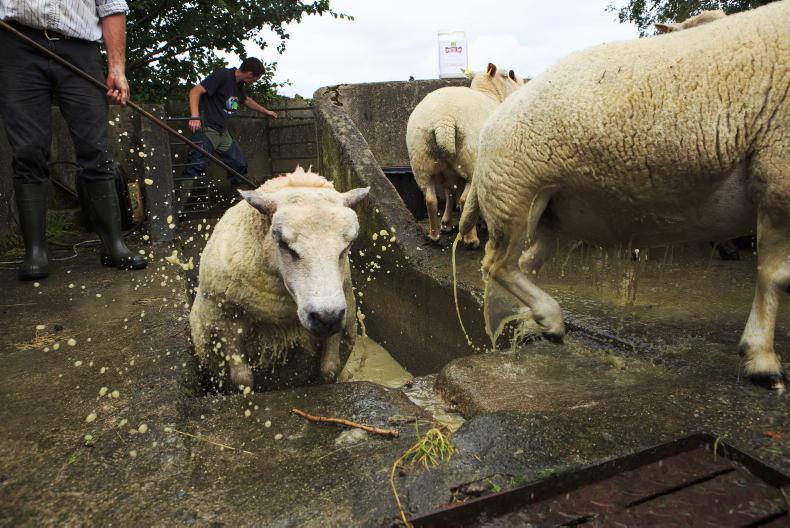When compared to wheat, disease control strategies in barley are often perceived as relatively straightforward.
This may seem the case but, unlike wheat where septoria is often the major target of control programmes, in barley the dominant disease can alternate between variety, location and season.
The false sense of security in barley may come from the fact that we have a range of fungicides that are still quite effective.
A little scratch of the surface reveals that it is not that simple and probably only partly correct.
Thankfully, we do have a range of fungicides that are still effective in barley. However, many of them do not provide the broad spectrum of activity that we might like them to have due to either poor intrinsic activity or the development of resistance in the main disease targets.
Indeed, careful consideration is required in devising fungicide control programmes for barley and getting it wrong can be very costly in disease conducive seasons.
Understanding variety
strengths and weaknesses
For barley disease control programmes, variety choice plays a huge role.
The deployment of mlo-based (Mildew Locus O) powdery mildew resistance across spring barley varieties has made a huge impact.
With all varieties now on the spring recommended list scoring an eight for resistance to this disease, the inclusion of specific mildewicides in fungicide programmes is no longer warranted in many cases. This is a clear example of where it is extremely important to know what variety has been sown – do not just assume it has resistance, you will need to check.
Unfortunately, this is not the case for winter barley. While there is decent resistance in some varieties, stalwarts such as KWS Cassia have a significant weakness for powdery mildew and it needs to be managed accordingly.
For the other major diseases, resistance ratings range from four to eight across both spring and winter barley, so scope does exist to match the fungicide programme in terms of fungicide intensity and fungicide choice to the variety.
One important score missing from the recommended list is ramularia. Although the Department of Agriculture is now screening for this disease, unfortunately they are not yet in a position to provide a rating.
Given the often-complex interactions that lead to ramularia developing, any such ratings will come with a note of caution.
It is equally unlikely that major differences exist in the levels of resistance among the current suite of varieties.
Subtle differences do exist, however. This is evident from trials, with the winter barley KWS Cassia likely to score slightly higher while Pixel would be regarded as quite susceptible.
However, we know that in the wrong season KWS Cassia can get a lot of ramularia so even if it were to be given a higher rating, this value will be heavily dependent on the season. This highlights the difficulties facing the Department in providing ramularia resistance ratings.
When is disease control needed
Unlike wheat, yield in barley is largely related to the number of grain sites created. Therefore, if potential grain sites are lost early the crop is not able to compensate to the level that wheat is. It could equally be argued that if there has been sufficient grain filling following flowering, we then do not need to keep a crop completely green until the very end.
The loss of potential tillers or stresses early will influence how many potential grain sites exist to drive yield potential
Both factors influence how we should then be thinking of disease control.
The loss of potential tillers or stresses early will influence how many potential grain sites exist to drive yield potential, while ramularia coming into a crop late will have minimal impact.
Control strategies
based on disease risk
With this in mind, the risk diseases pose to a crop should be assessed. For example, in a situation where barley is planted after barley, carryover of disease inoculum in the stubble will potentially lead to early infections.
In this situation, the first consideration should be given to varieties that score high for disease resistance, in particular rhynchosporium and net blotch.
However, planting time will also influence how a variety responds to disease, with those sown earlier both in winter and spring, more at risk of infection. Therefore, monitoring for disease from early in the season is vital.
While winter barley has the potential to produce new tillers up to a point, once it starts stem extension the contribution of tiller production beyond this is limited.
Therefore, where significant disease is present at the end of tillering, a fungicide treatment is warranted at this stage. In spring barley, as the season is more compact, the capacity to produce new tillers is limited and early control of disease is essential.
Matching fungicides
to disease risk
As highlighted earlier, the range of fungicides available have both strengths and weaknesses. Applying these to the different varieties can give combinations that may be too strong for one risk disease while being too weak for another. Hence the importance of knowing the variety and how it is likely to perform before a fungicide programme can be devised.
Some of the weaknesses in the different fungicides will be intrinsically linked to the molecule, but in most cases the weaknesses are related to fungicide resistance.
A mismatched combination of variety with fungicide, whereby the combination is not really required, may not result in any negative impacts on crop production but unwarranted application will only hasten the spread of any such resistance.
Resistance issues are
not confined to wheat
While septoria in wheat gets a lot of attention with regard to disease resistance, the various barley diseases are not without their problems.
Since the loss of chlorothalonil in 2020, ramularia has been the major disease to come into focus. Prior to its removal, chlorothalonil had masked significant fungicide resistance issues in ramularia populations that were going on in the background. These included the development of high levels of resistance to the SDHIs and prothioconazole, and their rapid spread through the population.
As we no longer have chlorothalonil, the weaknesses of these chemistries against ramularia are very evident, with significant losses of efficacy observed in both winter and spring crops. However, remembering that we do not necessarily need to keep the crop green to the very end, we can work with the residual efficacy levels by combining actives and including the multisite Folpet.
The loss of SDHI, prothioconazole and previously strobilurin sensitivity should also serve as a warning for Revysol, which currently provides decent levels of control. The inclusion of Folpet will help to protect the crop from ramularia, while good crop management is essential to reduce the level of any potential epidemic.
Ramularia is not the only disease that we need to think about in terms of fungicide resistance. We have previously picked up the G143A mutation, which is synonymous with strobilurin resistance.

Rhynchosporium continues to present a resistance threat but so far there have been very few issues for field control.
Fortunately, the mutation has not appeared to spread rapidly and its detection has been sporadic. Its detection highlights the fact that fungicide resistance mutations can occur in rhynchosporium.
This should be kept in mind in relation to the exposure we place on prothioconazole.
It has been and continues to be an excellent fungicide in barley, but we need to continue to protect it.
In addition, as with all other fungicides, we need to minimise its exposure whether this be through reduced doses or applications, while always ensuring that it is never applied alone.
Net blotch concerns
Resistance is also a major factor in the selection of fungicides for the control of net blotch.
We have known for almost a decade and a half now that strobilurin resistance exists in net blotch populations. However, unlike ramularia or septoria, or even the odd isolate of rhynchosporium, resistance in net blotch is due to a different mutation, F129L.

Fungicide resistance in net blotch has generated a lot of concern in parts of Europe in recent years.
The different mutations refer to different changes in the target site, in this instance a protein that is involved in fungal respiration which is how it gets its energy.
These changes tend to get in the way of the fungicide binding in the fungus and thus prevent it from killing the protein and the fungus. Although fungicides from the same family will all target the same protein, they can have different molecular structures which will all fit slightly differently.
In the case of F129L, this has prevented some strobilurins from doing their job (eg azoxystrobin) while having little or no impact on others (eg pyraclostrobin).
Unfortunately, over the past seasons, there has been a significant increase in the frequency of the F129L mutation in western European populations, including Ireland. Combined with this, we have also seen an increase in the frequency of mutations associated with SDHI resistance.
Although there are no reported resistance issues in Irish net blotch populations to prothioconazole, we know that its efficacy is dose responsive with a minimum of a half rate required in combination with another active to ensure good control.
Overall, the net blotch situation serves to demonstrate the complexity that exists in devising disease control programmes for barley – most varieties have moderate resistance but beware of those that are weaker.
There is little doubt that sowing barley after barley increases disease risk across the board and this practice will then require careful selection of fungicides to match that risk.
Successful disease control in barley is quite complex and should be significantly influenced by the genetic resistance of the variety grown, its sowing date and the weather. In barley, there is greater scope to build a fungicide programme based on a specific disease risk. Ramularia has been successful in overcoming the ability of most fungicide families to control it. There are significant concerns about the development of resistance in net blotch, especially in parts of the continent.
When compared to wheat, disease control strategies in barley are often perceived as relatively straightforward.
This may seem the case but, unlike wheat where septoria is often the major target of control programmes, in barley the dominant disease can alternate between variety, location and season.
The false sense of security in barley may come from the fact that we have a range of fungicides that are still quite effective.
A little scratch of the surface reveals that it is not that simple and probably only partly correct.
Thankfully, we do have a range of fungicides that are still effective in barley. However, many of them do not provide the broad spectrum of activity that we might like them to have due to either poor intrinsic activity or the development of resistance in the main disease targets.
Indeed, careful consideration is required in devising fungicide control programmes for barley and getting it wrong can be very costly in disease conducive seasons.
Understanding variety
strengths and weaknesses
For barley disease control programmes, variety choice plays a huge role.
The deployment of mlo-based (Mildew Locus O) powdery mildew resistance across spring barley varieties has made a huge impact.
With all varieties now on the spring recommended list scoring an eight for resistance to this disease, the inclusion of specific mildewicides in fungicide programmes is no longer warranted in many cases. This is a clear example of where it is extremely important to know what variety has been sown – do not just assume it has resistance, you will need to check.
Unfortunately, this is not the case for winter barley. While there is decent resistance in some varieties, stalwarts such as KWS Cassia have a significant weakness for powdery mildew and it needs to be managed accordingly.
For the other major diseases, resistance ratings range from four to eight across both spring and winter barley, so scope does exist to match the fungicide programme in terms of fungicide intensity and fungicide choice to the variety.
One important score missing from the recommended list is ramularia. Although the Department of Agriculture is now screening for this disease, unfortunately they are not yet in a position to provide a rating.
Given the often-complex interactions that lead to ramularia developing, any such ratings will come with a note of caution.
It is equally unlikely that major differences exist in the levels of resistance among the current suite of varieties.
Subtle differences do exist, however. This is evident from trials, with the winter barley KWS Cassia likely to score slightly higher while Pixel would be regarded as quite susceptible.
However, we know that in the wrong season KWS Cassia can get a lot of ramularia so even if it were to be given a higher rating, this value will be heavily dependent on the season. This highlights the difficulties facing the Department in providing ramularia resistance ratings.
When is disease control needed
Unlike wheat, yield in barley is largely related to the number of grain sites created. Therefore, if potential grain sites are lost early the crop is not able to compensate to the level that wheat is. It could equally be argued that if there has been sufficient grain filling following flowering, we then do not need to keep a crop completely green until the very end.
The loss of potential tillers or stresses early will influence how many potential grain sites exist to drive yield potential
Both factors influence how we should then be thinking of disease control.
The loss of potential tillers or stresses early will influence how many potential grain sites exist to drive yield potential, while ramularia coming into a crop late will have minimal impact.
Control strategies
based on disease risk
With this in mind, the risk diseases pose to a crop should be assessed. For example, in a situation where barley is planted after barley, carryover of disease inoculum in the stubble will potentially lead to early infections.
In this situation, the first consideration should be given to varieties that score high for disease resistance, in particular rhynchosporium and net blotch.
However, planting time will also influence how a variety responds to disease, with those sown earlier both in winter and spring, more at risk of infection. Therefore, monitoring for disease from early in the season is vital.
While winter barley has the potential to produce new tillers up to a point, once it starts stem extension the contribution of tiller production beyond this is limited.
Therefore, where significant disease is present at the end of tillering, a fungicide treatment is warranted at this stage. In spring barley, as the season is more compact, the capacity to produce new tillers is limited and early control of disease is essential.
Matching fungicides
to disease risk
As highlighted earlier, the range of fungicides available have both strengths and weaknesses. Applying these to the different varieties can give combinations that may be too strong for one risk disease while being too weak for another. Hence the importance of knowing the variety and how it is likely to perform before a fungicide programme can be devised.
Some of the weaknesses in the different fungicides will be intrinsically linked to the molecule, but in most cases the weaknesses are related to fungicide resistance.
A mismatched combination of variety with fungicide, whereby the combination is not really required, may not result in any negative impacts on crop production but unwarranted application will only hasten the spread of any such resistance.
Resistance issues are
not confined to wheat
While septoria in wheat gets a lot of attention with regard to disease resistance, the various barley diseases are not without their problems.
Since the loss of chlorothalonil in 2020, ramularia has been the major disease to come into focus. Prior to its removal, chlorothalonil had masked significant fungicide resistance issues in ramularia populations that were going on in the background. These included the development of high levels of resistance to the SDHIs and prothioconazole, and their rapid spread through the population.
As we no longer have chlorothalonil, the weaknesses of these chemistries against ramularia are very evident, with significant losses of efficacy observed in both winter and spring crops. However, remembering that we do not necessarily need to keep the crop green to the very end, we can work with the residual efficacy levels by combining actives and including the multisite Folpet.
The loss of SDHI, prothioconazole and previously strobilurin sensitivity should also serve as a warning for Revysol, which currently provides decent levels of control. The inclusion of Folpet will help to protect the crop from ramularia, while good crop management is essential to reduce the level of any potential epidemic.
Ramularia is not the only disease that we need to think about in terms of fungicide resistance. We have previously picked up the G143A mutation, which is synonymous with strobilurin resistance.

Rhynchosporium continues to present a resistance threat but so far there have been very few issues for field control.
Fortunately, the mutation has not appeared to spread rapidly and its detection has been sporadic. Its detection highlights the fact that fungicide resistance mutations can occur in rhynchosporium.
This should be kept in mind in relation to the exposure we place on prothioconazole.
It has been and continues to be an excellent fungicide in barley, but we need to continue to protect it.
In addition, as with all other fungicides, we need to minimise its exposure whether this be through reduced doses or applications, while always ensuring that it is never applied alone.
Net blotch concerns
Resistance is also a major factor in the selection of fungicides for the control of net blotch.
We have known for almost a decade and a half now that strobilurin resistance exists in net blotch populations. However, unlike ramularia or septoria, or even the odd isolate of rhynchosporium, resistance in net blotch is due to a different mutation, F129L.

Fungicide resistance in net blotch has generated a lot of concern in parts of Europe in recent years.
The different mutations refer to different changes in the target site, in this instance a protein that is involved in fungal respiration which is how it gets its energy.
These changes tend to get in the way of the fungicide binding in the fungus and thus prevent it from killing the protein and the fungus. Although fungicides from the same family will all target the same protein, they can have different molecular structures which will all fit slightly differently.
In the case of F129L, this has prevented some strobilurins from doing their job (eg azoxystrobin) while having little or no impact on others (eg pyraclostrobin).
Unfortunately, over the past seasons, there has been a significant increase in the frequency of the F129L mutation in western European populations, including Ireland. Combined with this, we have also seen an increase in the frequency of mutations associated with SDHI resistance.
Although there are no reported resistance issues in Irish net blotch populations to prothioconazole, we know that its efficacy is dose responsive with a minimum of a half rate required in combination with another active to ensure good control.
Overall, the net blotch situation serves to demonstrate the complexity that exists in devising disease control programmes for barley – most varieties have moderate resistance but beware of those that are weaker.
There is little doubt that sowing barley after barley increases disease risk across the board and this practice will then require careful selection of fungicides to match that risk.
Successful disease control in barley is quite complex and should be significantly influenced by the genetic resistance of the variety grown, its sowing date and the weather. In barley, there is greater scope to build a fungicide programme based on a specific disease risk. Ramularia has been successful in overcoming the ability of most fungicide families to control it. There are significant concerns about the development of resistance in net blotch, especially in parts of the continent. 












SHARING OPTIONS